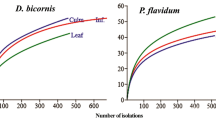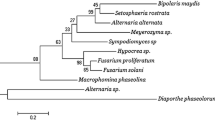Abstract
Endophytic fungi are rich in orchids and have great impacts on their host plants. 53 endophytes (30 isolates from Dendrobium devonianum and 23 endophytic fungi from D. thyrsiflorum) were isolated, respectively, from roots and stems of Dendrobium species. All the fungi were identified by way of morphological and/or molecular biological methods. 30 endophytic fungi in D. devonianum were categorized into 11 taxa and 23 fungal endophytes in D. thyrsiflorum were grouped into 11 genera, respectively. Fusarium was the dominant species of the two Dendrobium species in common. Antimicrobial activity of ethanol extract of fermentation broth of these fungi was explored using agar diffusion test. 10 endophytic fungi in D. devonianum and 11 in D. thyrsiflorum exhibited antimicrobial activity against at least one pathogenic bacterium or fungus among 6 pathogenic microbes (Escherichia coli, Bacillus subtilis, Staphylococcus aureus, Candida albicans, Cryptococcus neoformans, and Aspergillus fumigatus). Out of the fungal endophytes isolated from D. devonianum and D. thyrsiflorum, Phoma displayed strong inhibitory activity (inhibition zones in diameter >20 mm) against pathogens. Epicoccum nigrum from D. thyrsiflorum exhibited antibacterial activity even stronger than ampicillin sodium. Fusarium isolated from the two Dendrobium species was effective against the pathogenic bacterial as well as fungal pathogens. The study reinforced the assumption that endophytic fungi isolated from different Dendrobium species could be of potential antibacterial or antifungal resource.

Similar content being viewed by others
References
Aksoy DY, Unal S (2008) New antimicrobial agents for the treatment of Gram-positive bacterial infections. Clin Microbiol Infect 14:411–420. doi:10.1111/j.1469-0691.2007.01933.x
Arnold AE, Mejía LC, Kyllo D, Rojas EI, Maynard Z, Robbins N, Herre EA (2003) Fungal endophytes limit pathogen damage in a tropical tree. Proc Natl Acad Sci USA 100:15649–15654
Baute MA, Deffieux G, Baute R, Neveu A (1978) New antibiotics from the fungus Epicoccum nigrum. I. Fermentation, isolation and antibacterial properties. J Antibiot (Tokyo) 31(11):1099–1101
Bills GF (1996) Isolation and analysis of endophytic fungal communities from woody plants. In: Redlin SC, Carris LM (eds) Endophytic fungi in grasses and woody plants. Systematics ecology and evolution. APS Press, St. Paul, MN, pp 31–65
Chen J, Hu KX, Hou XQ, Guo SX (2010) Endophytic fungi assemblages from 10 Dendrobium medicinal plants (Orchidaceae). World J Microbiol Biotechnol. doi:10.1007/s11274-010-0544-y
Chen XM, Dong HL, Hu KX, Sun ZR, Chen J, Guo SX (2010) Diversity and antimicrobial and plant-growth-promoting activities of endophytic fungi in Dendrobium loddigesii Rolfe. J Plant Growth Regul 3:328–337. doi:10.1007/s00344-010-9139-y
Christina E, Maddox, Lisa ML, Li T (2010) Antibacterial activity of phenolic compounds against the phytopathogen Xylella fastidiosa. Curr Microbiol 60:53–58
Gong LJ, Guo SX (2009) Endophytic fungi from Dracaena cambodiana and Aquilaria sinensis and their antimicrobial activity. Afr J Biotechnol 8(5):731–736
Hormazabal E, Piontelli E (2009) Endophytic fungi from Chilean native gymnosperms: antimicrobial activity against human and phytopathogenic fungi. World J Microbiol Biotechnol 25:813–819
Hyde KD, Soytong K (2008) The fungal endophyte dilemma. Fungal Divers 33:163–173
Jon C, Michael AF, Christopher TW (2006) New antibiotics from bacterial natural products. Nat Biotechnol 24(12):1541–1550
Khan SA, Hamayun M, Yoon H, Kim HY, Suh SJ, Hwang SK, Kim JM, Lee IJ, Choo YS, Yoon UH, Kong WS, Lee BM, Kim JG (2008) Plant growth promotion and Penicillium citrinum. BMC Microbiol 8:231
Li WC, Zhou J, Guo SY, Guo LD (2007) Endophytic fungi associated with lichens in Baihua mountain of Beijing, China. Fungal Divers 25:69–80
Luo AX, He XJ, Zhou SD, Fan YJ, Luo AS, Chun Z (2010) Purification, composition analysis and antioxidant activity of the polysaccharides from Dendrobium nobile Lindl. Carbohydr Polym 79:1014–1019
Lv YL, Zhang FS, Chen J, Cui JL, Xing YM, Li XD, Guo SX (2010) Diversity and antimicrobial activity of endophytic fungi associated with the alpine plant Saussurea involucrate Karet Kir. Biol Pharm Bull 33(8):1300–1306
Michael AF, Christopher TW (2009) Antibiotics for emerging pathogens. Science 325:1089–1093
Mohanta J, Tayung K, Mohapatra UB (2008) Antimicrobial potentials of endophytic fungi inhabiting three ethno-medicinal plants of Similipal Biosphere Reserve, India. Internet J Microbiol 5(2)
Qin JC, Zhang YM, Gao JM, Bai MS, Yang SX, Laatsch H, Zhang AL (2009) Bioactive metabolites produced by Chaetomium globosum, an endophytic fungus isolated from Ginkgo biloba. Bioorg Med Chem Lett 19:1572–1574
Redman RS, Sheehan KB, Stout R, Rodriguez RJ, Henson JM (2002) Thermotolerance generated by plant/fungal symbiosis. Science 298:1581
Stierle A, Strobel G, Stierle D (1993) Taxol and taxane production by Taxomyces andreanae, an endophytic fungus of Pacific yew. Science 5105:214–216
Stinson M, Ezra D, Hess WM, Sears J, Strobel G (2003) An endophytic Gliocladium sp. of Eucryphia cordifolia producing selective volatile antimicrobial compounds. Plant Sci 165:913–922
Stobel GA, Daisy B (2003) Bioprospecting for microbial endophytes and their natural products. Microbiol Mol Biol Rev 67:491–502
Tan RX, Zou WX (2001) Endophytes: a rich source of functional metabolites. Nat Prod Rep 18:448–459
Tiwari R, Kalra A, Darokar MP, Chandra M, Aggarwal N, Singh AK, Khanuja SPS (2010) Endophytic bacteria from Ocimum sanctum and their yield enhancing capabilities. Curr Microbiol 60:167–171
Verma VC, Gond SK, Kumar A, Kharwar RN, Strobel G (2007) The endophytic mycoflora of bark, leaf, and stem tissues of Azadirachta indica A. Juss (neem) from Varanasi (India). Microb Ecol 54:119–125
Wang FW, Jiao RH, Cheng AB, Tan SH, Song YC (2006) Antimicrobial potentials of endophytic fungi residing in Quercus variabilis and brefeldin A obtained from Cladosporium sp. World J Microbiol Biotechnol 235:79–83
Wang Q, Gong Q, Wu Q, Shi J (2010) Neuroprotective effects of Dendrobium alkaloids on rat cortical neurons injured by oxygen-glucose deprivation and reperfusion. Phytomedicine 17:108–115
Weber RWS, Kappe R, Paululat T, Mösker E, Anke H (2007) Anti-Candida metabolites from endophytic fungi. Phytochemistry 68:886–892
White TJ, Bruns TD, Lee S, Taylor JW (1990) Amplification and direct sequencing of fungal ribosomal RNA genes for phylogenetics. In: Innis MA, Gelfand DH, Sninsky JS, White TJ (eds) PCR protocols: a guide to methods and applications. Academic Press, New York, USA, pp 315–322
Xu LL, Han L, Wu JZ, Zhang QY, Zhang H, Huang BK, Rahman K, Qin LP (2009) Comparative research of chemical constituents, antifungal and antitumor properties of ether extracts of Panx ginseng and its endophytic fungus. Phytomedicine 16:609–616
Zampini IC, Vattuone MA, Isla MI (2005) Antibacterial activity of Zuccagnia punctata Cav. ethanolic extracts. J Ethnopharmacol 102:450–456
Zhang Y, Liu S, Che Y, Liu X (2007) Epicoccins A-D, epipolythiodioxopiperazines from a Cordyceps-colonizing isolate of Epicoccum nigrum. J Nat Prod 70(9):1522–1525
Zhang W, Krohn K, Egold H (2008) Diversity of antimicrobial pyrenophorol derivatives from an endophytic fungus, Phoma sp. Eur J Org Chem 25:4320–4328
Zhang P, Zhou PP, Yu LJ (2009) An Endophytic taxol-producing fungus from taxus media, Cladosporium cladosporioides MD2. Curr Microbiol 59:227–232
Acknowledgment
We would like to thank Dr. Youxin Wang for carefully reviewing the manuscript. The research was financially supported by the National Natural Sciences Foundation of China (No. 30830117, 31070300, 30900004) and the National High Technology Research and Development Program of China (No. 2008AA09Z405), and New Drug Preparation Project-Ministry of Science and Technology of China (2009ZX09502-025) and Research of Traditional Chinese Medicine Industry (200807042).
Author information
Authors and Affiliations
Corresponding author
Rights and permissions
About this article
Cite this article
Xing, YM., Chen, J., Cui, JL. et al. Antimicrobial Activity and Biodiversity of Endophytic Fungi in Dendrobium devonianum and Dendrobium thyrsiflorum from Vietman. Curr Microbiol 62, 1218–1224 (2011). https://doi.org/10.1007/s00284-010-9848-2
Received:
Accepted:
Published:
Issue Date:
DOI: https://doi.org/10.1007/s00284-010-9848-2




